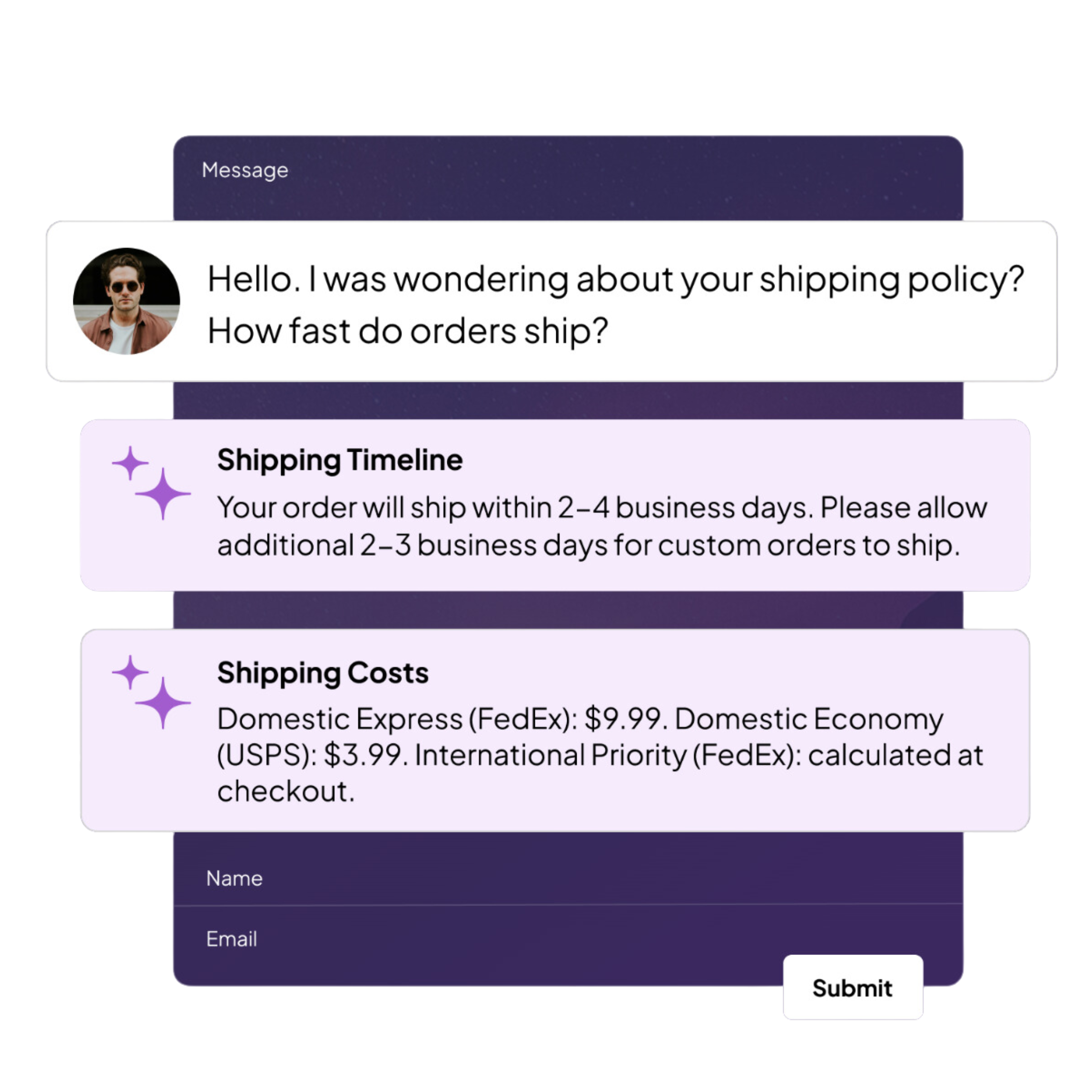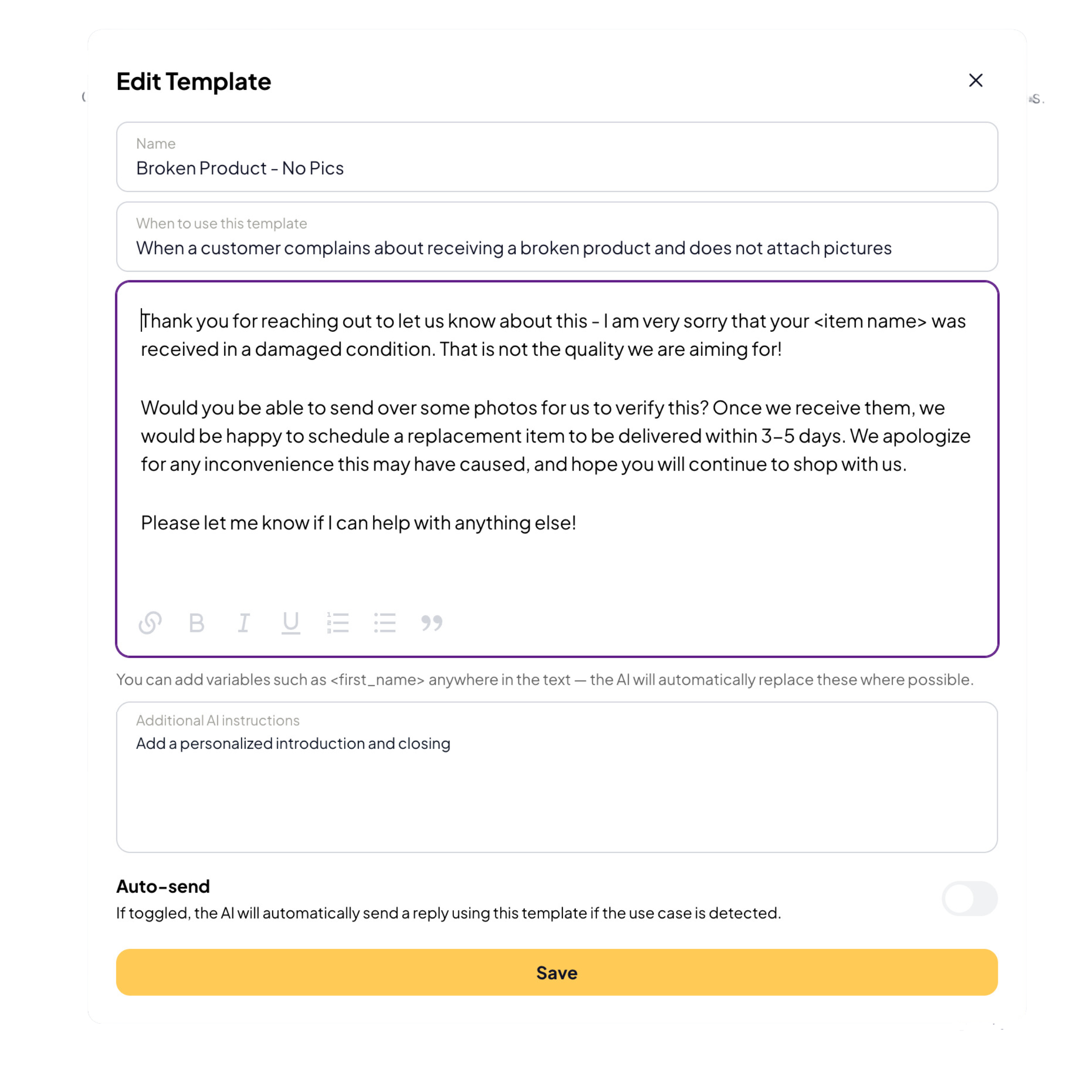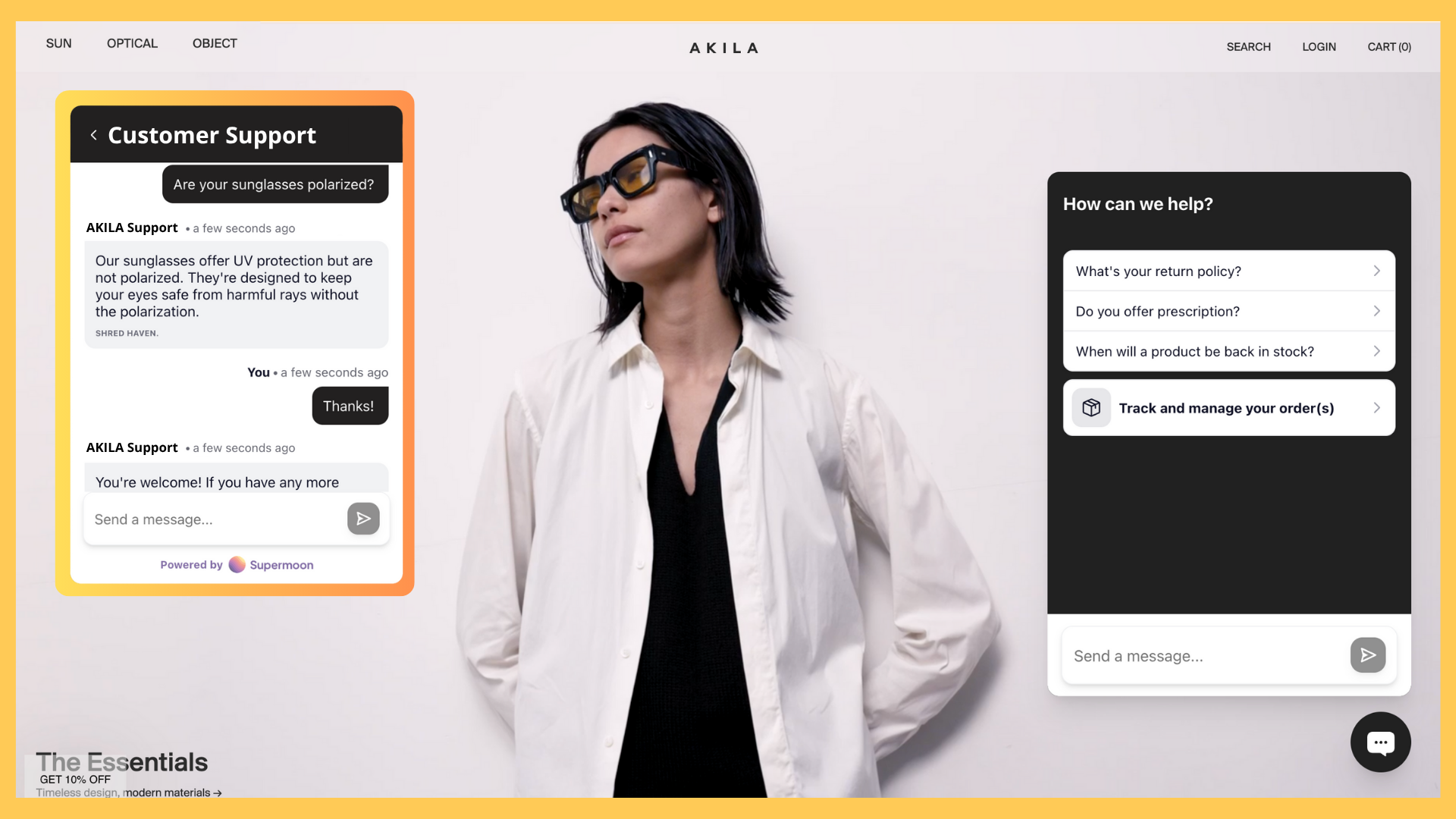Unpacking the ROI of Proactive Customer Support in Ecommerce [Examples + Automation Tips Inside]
Great service often turns into great reviews, which matters because 96% of your customers check reviews before purchasing. In this article, we will break down what proactive customer support truly means and what it can do for your bottom line.

In ecommerce, speed gets all the attention.
Instant responses.
Fast delivery.
Quick returns.
But speed isn’t always the answer.
Let’s say your customer just spent $200 on a bundle but had no idea that one item ships separately.
They reached out three days later (confused and annoyed).
If you had proactively flagged the partial shipment in advance, that ticket might never have happened. That amount of frustration might never have occurred.
Proactive customer support means solving problems before they hit the inbox.
It prevents confusion, preempts complaints, and protects revenue.
It’s not just about delighting your customers; it’s also about controlling the outcomes.
According to Salesforce, while 61% of service professionals think they’re being proactive, only one-third of customers agree.
Another report revealed that:
- 71% of customers say they’d rather get help before they have to ask
- And 72% of those who receive it walk away with a better opinion of the brand
Great service often turns into great reviews, which matters because 96% of your customers check reviews before purchasing.
In this article, we will break down what proactive customer support truly means and what it can do for your bottom line.
We will also look at:
- Why does proactive support matter in 2025?
- The connection between better Customer Experience (CX) and measurable revenue
- How sentiment signals help save revenue
- Where Supermoon fits into the proactive support stack
First up, what is proactive customer support?
Proactive customer support is about making the first move. This means helping customers before they run into problems.
Instead of waiting for tickets to pile up, support teams reach out with useful information, resolve predictable issues early, provide self-service tools, and automate gentle nudges.
This approach can be direct, like a message from a support agent when an order delay is detected.
Or indirect, like a help article sent based on browsing behavior or a recent purchase.
More examples of proactive support:
- Notifying the customer when an item in their cart is low in stock, instead of letting it sell out silently
- Auto-triggering a message from support when a customer struggles at checkout for longer than usual
- Confirming address accuracy before an item ships to reduce failed deliveries
- Displaying estimated back-in-stock dates automatically on Product Detail Pages (PDPs) for high-interest out-of-stock items
Proactive customer support builds trust by answering unspoken questions. For ecommerce teams, this helps raise the ROI of ecommerce support with fewer escalations, higher retention rates, and lower return handling costs.
According to Gartner, this kind of support increases the customer’s Value Enhancement Score by 9%, a strong signal for future repeat purchases and long-term brand trust.

Brands that have benefited from proactive customer support have seen:
- Reduction in return rates owing to smart product sizing support
- Fewer “Where is my order?” (WISMO) inquiries because of order status transparency
- Improvements in the repeat purchase rate and Lifetime Value (LTV) due to timely replenishment nudges
- Saved margin on high-risk orders from proactive fraud checks
Why proactive support matters in 2025
As per Gartner’s 2021 prediction, proactive support is expected to lead the way by 2025. Today, that’s not a prediction; it’s the baseline for ecommerce brands that want to keep customers coming back.
The rise in proactive support isn’t just another passing CX trend. It’s tied to the revenue impact of CX. This comes in tow as buyer expectations are evolving. Many ecommerce buyers won’t wait for a late delivery to ask where their order is. They won’t take the time to explain a broken checkout flow.
They expect the brand to know.
As a result, 80% of customers say experience is as important as the product or service offered. Keeping up with this expectation, 89% of businesses now compete primarily on CX.
Instead of waiting for complaints, teams are using ecommerce support automation tools to detect and solve problems early. When automated correctly, these tools flag risks in advance, reduce contact volume, protect LTV, and improve retention.
Here’s what reactive vs. proactive customer support looks like in practice:
| Scenario | Reactive support approach | Proactive support approach |
| Customers submit complaints about poor fit or misleading sizing | Support logs the complaints and flags the product team | Auto-emails sent after returns, coupled with on-site survey patterns, feed into real-time size guide improvements |
| High-ticket customers leave poor reviews after first orders | Brand responds publicly or via email to save face | Order data + CSAT triggers a concierge follow-up before they even leave a review |
| Spike in failed deliveries during the holiday season | Support scrambles to resolve WISMO queries | At-risk shipments flagged by carrier APIs, customers notified in advance with options to reroute |
| Subscription cancellations spike after the third cycle | Customers explain issues during the cancel flow | Behavior tracked in cycles 1–2; those showing churn signals receive early check-ins or offers |
| Repeat buyers request discounts manually | Support handles coupon code requests manually | High-value segments auto-receive timed incentives before the typical reorder window |
Brands that adopt the proactive customer support model are also rethinking their metrics:
- From average resolution time → to fewer contacts
- From cost-per-contact → to the value of zero-contact resolution
- From tracking CSAT post-resolution → to reducing the need to resolve
- From headcount cost → to retained revenue per agent
The ROI levers behind proactive support in ecommerce
Imagine you walk into a cafe and the barista already knows you by name and offers your usual brew.
That kind of experience builds loyalty.
In ecommerce, a similar kind of delightful service can multiply revenue.
- Customers who enjoy great CX are said to spend 140% more than those who don’t.
- For subscription brands, that translates into a 74% higher chance the customer will stay beyond year one.
Proactive CX is the engine behind these results. It scales repeat purchases, cuts churn, and shifts support from an expense to a profit center.
A Reddit user laid out a simple framework that can be used to turn tickets into triggers for CX improvement.

Let’s run through a few more tactics that will help CX leaders quantify the impact of proactive support.
Identifying and solving problems at the first sign of trouble
Support tickets are signals. Smart brands treat them like a product feedback loop. If 10 customers report loose buttons on a new shirt style, the best teams alert sourcing before 1,000 more units are shipped out.
How do you do this?
Some brands use AI to flag frequent post-purchase issues, like unclear assembly instructions or missing components.
While some others monitor review sentiment to catch defects early and pause restocks.
With a strong feedback loop tying your support, ops, and product teams, you can prevent support tickets before they happen and reduce refund rates without lifting your spend.
Responding before the customer asks
Trigger-based emails and auto-replies can handle routine questions before tickets are raised.
Proactive messaging isn’t new, but few brands do it right.
What do leading ecommerce brands do?
- Offer product recommendations or combos using widgets based on the product page being viewed
Net-a-porter adds dynamic, scrollable product recommendation widgets on product pages, showing bestsellers and “You may also like” suggestions based on real-time browsing behavior.

- Auto-send “how to care for” tips for high-AOV (Average Order Value) products once they ship
- Trigger upsell offers when a product runs out or wears down
Gymshark encourages bundled purchases by displaying “People also bought” on the product page.

- Share order updates the moment a shipment gets delayed, not when the customer sends an email
With tools like Supermoon, you can use templates to fast track these replies and personalize them as seen below:
“Hey <first_name>,
We saw your serum just shipped—some customers ask if it tingles. Totally normal! Here’s how to apply it: [link]
– <agent_name>”
This results in:
- Fewer WISMO tickets
- Higher repeat orders
- Lower return rates (especially for sizing, care, and assembly-related items)
- More first-to-second purchase conversions
-
Turning product questions into purchase conversions
When a customer asks about color variants, bandwidth, or model compatibility, automatic replies with product links drive immediate conversions. Supermoon’s AI uses template responses, packed with product names, order details, and links, making answers instant and helpful.
A template might say:
“Hi <first_name>,
You asked about matching straps for your watch (order #[order_number]). Here’s the link: [product_link]. Happy to share more color options if you’re interested.
– <agent_name>”
Done right, this doesn’t just reduce ticket volume; it closes more carts.
How sentiment becomes a revenue signal
Most teams treat sentiment as a support metric. But its real power shows up when it feeds into operations, product, and growth planning.
Every message holds signals, not just about the individual ticket, but about systemic blockers across the business.
Here are a few ways in which sentiment scoring can be used to shape proactive CX workflows.
Spot churn risks early to protect retention
Time-to-resolution metrics only tell you how quickly support responded. Sentiment tells you if the customer left annoyed.
- Brands that cross-check tone with return patterns or drop-off behavior find early signs of churn 2 to 3 weeks before it shows in NPS or reorder data
- You can flag subscribers whose tone worsens across touchpoints (even if CSAT scores remain high)
- Negative tone + repeat tickets tied to logistics or setup may point to missed expectations, not operational failure
Identify product risks before tickets pile up
Sentiment, when filtered by SKU, becomes a feedback loop for product, fulfillment, and logistics.
- Combining tone signals with ticket metadata (SKU, warehouse, order size) helps you catch systemic issues faster (e.g., certain 3PLs causing delays or breakage)
- A confused tone in PDP chats can signal missing information (it could be details on fit, delivery, or usage)
Train your support team in emotion, not just ticket types
Your support staff can pick up real-world training cues using insights from sentiment analysis.
- Make a note of phrases that ease the tone mid-conversation
- Instead of generic empathy scripting, train agents on calming language tied to specific ticket types (like delays, sizing confusion, and missing orders)
- Flag macro replies that lead to a tone drop across multiple agents; they are a sign of tone mismatch, not an agent error
How Supermoon’s AI helps ecommerce brands in providing proactive support
When support teams wait to react, they fall behind. The AI-first customer support platform, Supermoon, is built to help brands react before problems escalate.
Every feature is designed to help ecommerce teams handle fewer tickets and prevent issues from slipping through the cracks.
Here’s how Supermoon powers proactive customer support workflows:
Contact form with built-in product detection
Supermoon’s Smart Contact Form does more than collect issues; it acts as a lightweight sales tool. When customers mention a product, it automatically links to that item’s page. This reduces back-and-forth while nudging customers toward resolution and conversion at once.
Teams using this form see up to a 70% drop in ticket volume and fewer WISMO or pre-purchase questions clogging up support.

With this feature, brands can:
- Suggest immediate answers as customers type, powered by an AI teammate trained on your knowledge base, FAQs, and your store
- Detect product names in real time and links to PDPs automatically
- Capture every question, even abandoned ones, turning lost intent into fresh CX and marketing data
Sentiment tagging
Every incoming message is scanned and tagged with emotional tone and urgency using emojis. This gives agents the emotional context they need to respond well and quickly.
- Emojis show the tone of tickets (frustrated, happy, or upset) at a glance
- It flags high-risk or time-sensitive conversations for faster resolution
- And helps prioritize responses to repeat buyers and long-term customers
AI analytics dashboard
Supermoon arms your CX team with the full story: real purchase data, refund patterns, and customer behavior, all in one place.
CX teams can:
- Be more proactive and take action early by analyzing the top inquiries and topics received
- Gauge CX quality even without customer feedback by comparing pre- and post-resolution sentiment
- Compare tone, ticket history, and resolution time data to assign an AI CSAT score
Automatic email replies

Your team shouldn’t be spending time answering FAQs. Supermoon’s AI email assistant now replies to those FAQ emails automatically, using product data, refund policies, shipping timelines, and any other details you have trained the AI assistant on.
This is how it works:
- Upload your website or FAQ link, and Supermoon will personalize replies to suit your brand’s tone instantly
- Get ready-to-send drafts in your team’s inbox and rephrase them to your liking
- The AI assistant also tags, sorts, and summarizes messages so your team can prioritize tickets faster
- Respond to your customers, whether you speak their language or not, using Supermoon’s multilingual support capabilities
Turn your support team into a retention engine with Supermoon
Support teams today don’t have the time or bandwidth to manually manage every ticket.
And they shouldn’t have to.
With Supermoon’s proactive support capabilities built into your inbox and chat, you can resolve issues before they turn into complaints.
Supermoon helps CX teams cover more ground. It tags urgent tickets, drafts replies, sums up full conversations, and flags accounts that need follow-up, so reps can jump in only when it matters.
AKILA, the luxury eyewear brand, now saves 50+ hours a month by automating order updates and product questions through Supermoon.

If you’re measuring the ROI of ecommerce support or looking to turn CX into a customer service profit center, Supermoon helps you get there without growing your headcount.
Try Supermoon today and keep your customer support proactive, lean, and revenue-positive.
Ready to get started?
Don't miss out on the opportunity to leverage the power of AI. Take the leap into the future now!
Try for free


